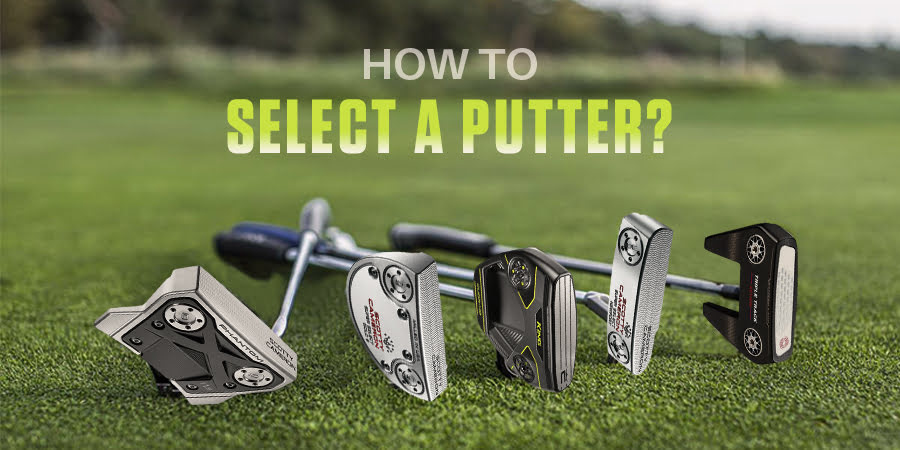How to Select a Putter: Your Step-by-Step Guide

Arguably the most important club in our bag, the putter makes up 50% of our score card. It is perhaps the most frequently changed club as compared to any other club, and that’s why most golfers have more than one putter in their arsenal. Here’s a shocking stat: 80% of golfers are not fit properly for their stroke type.
Putting is one aspect of the game that is very individualistic, where no one size fits all. Hence, most of the factors rely more on the feel of the player than on numbers.
Having said that, we are not denying the fact that, to achieve the best results, we need to find a putter that suits our stroke and is technologically packed!
Where a proper putter fitting session with a professional is essential in determining the right putter for you, here are a few factors you must consider while buying one on your own:
- Grip
- Length
- Lie Angle
- Head Design
- Types of putters
GRIP:
Putter grips are available in different thicknesses, shapes, weights, lengths, and materials. The weight of the grip should be in congruence with the putter head. In a case where the putter grip is too thick and heavy, the putter head will feel very light. The grip can be chosen according to the player’s preference for holding the putter. For instance, for someone who prefers a traditional reverse overlap, a standard grip size would be ideal.
Most players are now switching to thicker grips as it reduces the excessive work of the hands and lets the bigger muscles do the job with minimal wrist movement.

LENGTH:
Determines overall posture, how the eye line falls over the ball, and the lie angle. Finding the right length of putter is crucial to producing quality strikes and consistent putting. The standard length of putters ranges from 32 to 36 inches, which helps promote a pendulum swing in the putting stroke.
LIE ANGLE:

The Lie angle is interlinked with the shaft length. The sole of the putter should rest absolutely flat on the green. If either the toe or the heel is lifted, it can lead to twisting of the face at impact and off-centre strikes.
HEAD DESIGN:
MALLET VS BLADE PUTTERS:
In the last couple of decades, technology has been at the forefront and revolutionised how we live today to a large extent. Both blades and mallets have come a long way, yet confusion about which one is better still prevails.
Blade Putters:
We see most professional players using blade putters as they provide tremendous feel, precision, and control. The heel-toe weighting has brought more forgiveness to the blades, which in turn helps golfers find more consistency. They are best suited for players with a slight to strong arc-type putting stroke, as it allows for opening and releasing of the face. The only disadvantage of blades is that they are not as forgiving as a mallet and are a little harder to line up.
Mallet Putters:
Mallets In general, they offer more forgiveness as compared to blade putters because of their bigger head design and, thus, a larger sweet spot due to their high MOI (moment of inertia).
The visual technology helps with better aim and alignment; the shaft technology (centre shafted putters) can be chosen based on the stroke type; and the high MOI helps with off-centre strikes, all of which can help you hole more putts. Mallets are ideal for players with a straight back or straight through stroke. They are recommended for beginners as they make learning easier for them. However, mallets may not offer the best performance on faster greens.
TYPES OF PUTTERS:
It is the intersection point of the shaft line going into the centre of gravity of the head that determines the arc type and how the club hangs. Based on that, there are three main types:
- Face balanced
- Toe Hang
- Slight arc

FACE BALANCED PUTTERS:
They have the centre of gravity directly below the axis of the shaft, which makes the putter face point upwards when you balance the shaft on your finger. The opening and closing rates of the putter in the backstroke and follow-through, respectively, are minimal; hence, they are best suited for players with a straight putting stroke.
TOE HANG PUTTERS:
Toe-hang putters are putters whose toe points to the ground when you balance the shaft on your finger. This indicates that the centre of gravity is not precisely below the shaft axis. Toe-balanced putters are more likely to open and shut throughout the stroke, making them ideal for golfers with an arc in their putting stroke.
SLIGHT ARC PUTTERS: (How to find your arc type?)
Not every putter has to be balanced or face-oriented. A lot of putters have some toe hang and fall somewhere in the middle. These are recommended for players with just a slight in-to-in or in-to-square arc in their putting stroke with minimal face rotation.
While it is imperative to match your stroke type with the correct balance of the putter to hole more putts consistently, the question arises: how do you determine your stroke type?
There can be three types of putting strokes:
- straight back—straight through
- into in
- into square

Here's a quick method to find out for yourself: Make a few putts with two alignment sticks putter head-width apart. You can also record it from behind to get a more accurate picture. Examine the movement of the putter with respect to the alignment stick. The more the putter head moves away from the stick, The stronger the arc,
PUTTER FITTING TIP:
When going for putter fitting, don’t randomly hit putts; select the one with which you have holed three putts in a row. Putters perform differently at different distances. So hit the same number of putts from 5, 10, and 20 feet, and then draw your conclusion. Compare it with your current putter to see if there is actually any difference in the result.
CONCLUSION:
With putting having the most weight in the game, using the wrong putter only puts you at a disadvantage. Statistics prove that with all the new and improved technology today, the right putter can definitely help lower your score and eliminate all those 3 putts... or 4 putts.






Please to comment on this post.